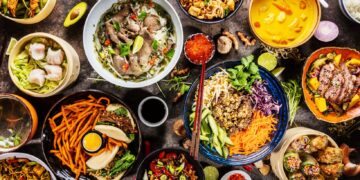Preparation
Frying chicken without eggs is a straightforward process that requires very few ingredients. The first step is to gather the necessary ingredients: chicken, flour, black pepper, liqour, and a small amount of baking powder. Once you have all the ingredients, it’s time to start prepping the chicken. Start by washing and draining the chicken, then cut it into smaller pieces. Next, you’ll need to season the chicken with the black pepper and liquor for flavor. Finally, combine the flour, baking powder, and any other desired spices in a small bowl. Once all the ingredients are ready, you’re ready to begin cooking.
Gather ingredients
Before you begin preparing your chicken, it’s important to have all of your ingredients and equipment gathered. You will need the following:
-Chicken pieces
-Flour
-Garlic powder
-Onion powder
-Paprika
-Salt and pepper, to taste
-Oil, for frying (vegetable, canola or peanut oil work best)
-Large skillet or deep fryer
-Tongs or slotted spoon for flipping the chicken during frying
Cut chicken into desired pieces
Cut the chicken into pieces of your desired size, usually 4-6 ounces. To achieve a crispy texture and quick cook time, aim to keep the pieces the same size so they will cook evenly. Be sure to discard any excess fat and remove the skin before cutting. It’s also helpful to cut off any excess cartilage or fat before cooking as this can make it harder for the chicken to crisp up. After cutting, place the pieces in a shallow bowl and cover with a damp paper towel – this prevents them from drying out while you prepare other ingredients.
Breading
Breading is one of the most popular methods of cooking chicken without eggs. It involves coating the chicken pieces in a flour-based mixture seasoned with herbs and spices, and then frying it in hot oil. This method produces a delicious, crispy texture that is sure to please even the most finicky eaters. Let’s take a look at the steps needed to make this classic fried chicken dish.
Mix together breading ingredients
When preparing fried chicken without eggs, it’s important that you create a flavorful and crunchy coating for the meat. To do this, start by combining all of your dry ingredients in a shallow bowl or baking dish. All-purpose flour is the primary ingredient in most breading mixtures and should be combined with an equal portion of cornmeal. Other ingredients such as seasoning salts, herbs, spices or even grated Parmesan cheese can be added to create a more complex flavor profile. The dry ingredients should essentially cover the chicken on all sides once tossed in, but you may choose to add an extra layer of seasoning if desired.
Dip chicken pieces into breading mix
Before you can get to the frying part, you’re going to need to bread the chicken. You can create one out of seasoned flour, or a dry breading mix purchased from your local grocery store.
To assemble the coating, simple combine one cup of flour (or dry breading mix) with half teaspoon each of salt and pepper. To keep it vegan or allergy friendly, skip the egg wash and use a dairy-free milk such as almond milk or coconut milk instead.
Once all the ingredients are combined, coat each piece of chicken in the mixture. If using plain flour and no egg wash, be sure to press down hard on each side for maximum coverage. This will ensure your chicken pieces are fully coated once fried.
Frying
Frying chicken without eggs is possible and can be done with just a few simple ingredients. Not only is it a healthier option than traditional fried chicken, but it can also be a great way to get creative with your cooking. Whether you’re looking for a new dish to add to your repertoire or just want to try something new, a fried chicken without eggs recipe is an enjoyable way to do it. Let’s get into the details.
Heat oil in a large skillet
Before you begin frying, make sure that you have the right ingredients and kitchen tools on hand. You will need a large skillet or pot with a lid, cooking oil such as vegetable, peanut or sunflower oils, and some kind of breading or batter mixture of your choice.
Before adding the chicken pieces to the skillet, heat up the oil on medium-high heat until it’s hot enough to cook your food. Using a cooking thermometer is recommended as different types of oil may require different temperatures. It is also important to monitor the temperature while you’re cooking because too much heat can cause the chicken to become dry and excess oil can leave it greasy. Fry your chicken in batches so that it cooks evenly. Make sure not to crowd the pieces in order for them to get cooked through without burning them. Use tongs or chopsticks when flipping over parts for even cooking on both sides. Fry each piece for about 7-10 minutes per side until golden brown and crispy before removing from heat and draining excess oil on paper towels.
Fry chicken pieces in hot oil
Frying is a popular cooking method used around the world. It requires the use of hot oil to cook food quickly and evenly. When frying, it is important to keep heat and oil levels consistent, so that the outside of your food does not burn and become too dark, while the inside remains uncooked.
When frying chicken pieces, it is best to use a deep pot or saucepan filled with enough oil to allow the chicken pieces to be fully immersed. Activate your heat source and bring your oil to medium-high heat (350°F/180°C). Using long tongs, carefully lower your chicken into the hot oil and cook until golden brown – usually 8–10 minutes. Stir frequently with a wooden spoon or spatula in order to prevent sticking and burning.
Once cooked thoroughly through (internal temperature of 165°F/74°C), remove your fried chicken pieces from the pan with long tongs onto a plate lined with paper towels in order for any excess oils to be absorbed by the absorbent paper. Allowing fried food items some time (~5 minutes) on absorbent paper allows for all additional surface oils/residues from frying process to sufficiently drain away from foods before serving or storing.
Finishing
Frying chicken without eggs is actually much simpler than it may sound. With the right supplies and a little bit of time and effort, you’ll be able to make crunchy, flavorful fried chicken without needing to go through the hassle of having to crack open and separate eggs. This section will cover the process of preparing, pre-cooking, and frying chicken without using eggs.
Remove chicken pieces from skillet
Once chicken pieces are lightly browned and cooked through, remove them from the skillet with a pair of tongs or a large fork. Allow the chicken to cool for a few minutes before serving. To ensure even cooking, feel free to cut into one of the larger chicken pieces to make sure that it is indeed cooked through to the center – there should be no raw, pink portions remaining. For optimal crispness, serve shortly after frying and avoid setting aside for extended periods of time. To retain maximum crispness while serving or storing leftovers, keep fried chicken in a warm oven on low temperature (200°F) until ready to eat.
Sprinkle with desired seasonings
Once the chicken is fully-cooked, you can sprinkle it with any desired seasonings. Some popular seasonings for fried chicken include paprika, garlic powder, pepper, cumin, chili powder, onion powder and more. Be sure to adjust the amount of these according to your taste preferences. If preferred, you can also lightly coat fried chicken with a light glaze or barbecue sauce for an extra savory kick – however this will alter the original flavor of the dish. Additionally, feel free to add additional herbs like parsley or thyme over the top for visual appeal and extra flavor.
Serve chicken with desired accompaniments
Once the chicken has finished frying, it is ready to be served. Plate the fried chicken with your desired accompaniments such as salads, sauces, and sides. Enjoy the crispy and juicy flavors of fried chicken without the help of eggs.
For storage, you can keep cooked fried chicken in covered containers or wrap pieces individually in aluminum foil or freezer paper to store. Be sure to discard any cooked fried chicken after two days if it has not been eaten.











